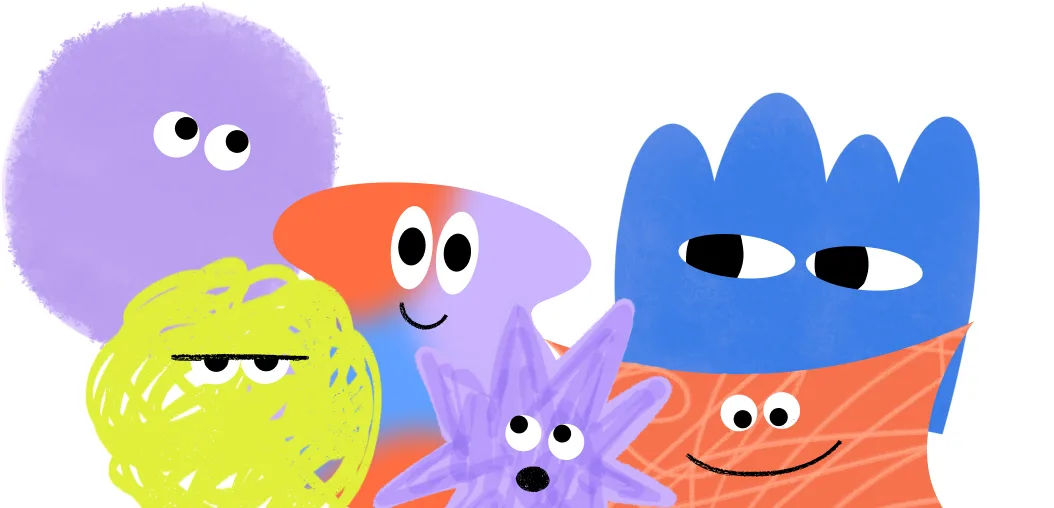You might not think about common pronouns like “you,” “me,” and “we” as you use them in your everyday speech. But if you’ve got a toddler at home, have you thought about how they learn to use these words?
Whether it's nouns, verbs, adjectives, or pronouns, all parts of speech come together to help people communicate clearly. Pronouns are a big part of language development, and using them can help kids more accurately express what they’re trying to say.
While some kids naturally pick up pronouns on their own, others need some help learning how to use them. Here are some tried-and-true expert tips for teaching your child to use pronouns at home.
Curious or concerned?
Our free screener is tailored by age and covers all areas of speech, language, and feeding. Find out if your child might need speech therapy.
 Screener for children
Screener for childrenDifferent types of pronouns to practice
There are several types of pronouns in the English language:
Possessive pronouns – such as my, mine
Second person – such as you, your, yours
Singular and plural – such as I, me, we, us
Third person – such as he/she, him/her, they/them, his/hers/theirs
Reflexive pronouns – such as herself, himself, themselves
Toddlers typically start off using pronouns that relate to themselves, such as my, mine, I, and me. These pronouns are usually acquired earlier in a child’s speech. Have you ever heard a little one say “Mine!” or “Me!” when trying to express what they want? That’s a great example of early usage of pronouns!
When should pronouns be taught to kids?
You can begin modeling and teaching pronouns at any age! We use pronouns every day in our speech, so it’s important for children, even babies and toddlers, to hear how they’re used.
At what age do children start using pronouns?
Here are the pronouns that children are typically able to say at each age:
12-26 months: I, it
27-30 months: you, me, my, mine
31-34 months: your, yours, he, she, we
35-40 months: they, them, us, his, her, hers
41-46 months: its, him, our, ours, their, theirs
47+ months: herself, himself, themselves (reflexive pronouns)
How to teach pronouns to your child
No matter which pronoun you're working on, children learn best by hearing someone model the word for them. One way to do this is to narrate, or describe, what you’re doing when you’re with your child so they can listen.
Let’s say you’re building a tower of blocks together. You might say, “I stacked it!” “I have my block!” “My block is green!” “That block is mine.”
You can also say, “Who is ready to play blocks? Me!” Then raise your hand to signal you’re referring to yourself.
To help your child use pronouns in their speech, listen to their responses as you interact together, and look for natural opportunities to help them use these words. Let’s say your child is hungry and says, “Snack?” You can model pronouns like this: “You want your snack. Say, ‘My snack?’” or “You want your snack. Say, ‘I want snack!’” These are natural (and motivating!) chances for your child to begin using longer phrases that include pronouns.

3 fun activities for teaching pronouns
1 Play interactive games
Second-person pronouns can be fun to teach with games like peek-a-boo. Think about how you play peek-a-boo. Your child hides behind a blanket or their hands. You say, “Where are you? Where did you go?” Then your child pops out with excitement. You respond by saying things like, “There you are! I see you! I found you!” Keep playing, and your child will soon begin to understand the meaning of the word “you.”
2 Use body parts
You can also try singing a song like “Head, Shoulders, Knees, and Toes” together. After you sing, take different body parts and say, “I see your nose! That’s yours,” and point to their nose. You can go on and on as long as your child is engaged.
Also try giving a comparison: “Where’s your nose? Here’s yours! Here is mine!” Point to each person’s nose as you talk about it together.
3 Use a variety of toys
When teaching your child third-person pronouns, toy figurines, stuffed animals, doll houses, cars, and books with lots of pictures can all be helpful. Children learn best through play, so take advantage of that! For example, as you play together, talk about what the toy figures are doing. You can say things like, “He is eating,” “She is sleeping,” or “They are driving.”
You can set up some specific activities to see how well your child understands pronouns. Try this: Take a boy baby doll and lay him down in a crib. You can model, “He is sleeping. Shh!” Or give your child the chance to say this as well, by asking, “What is happening here?”
Next, switch the boy doll with a girl doll and say, “She is sleeping! Shh!” or ask, “What is happening here?” If you lay both babies in the crib, you can model, “They are both sleeping!”
What to do if your child isn’t using pronouns correctly
If you’ve been working on pronouns with your child and they are either misusing them or not saying them at all, it’s a good idea to look at their overall language development.
If your child has a speech or language delay, they’re likely struggling with more than just pronouns. There are other signs of delay to look for, such as not using enough words for their age, using too short of phrases for their age, or speaking in sentences that don’t make much sense. Take a look at the speech and language milestones expected for your child’s age here:
Could your child have a speech delay?
Take our screenerCan a speech therapist help a child learn to use pronouns?
If your child is having trouble learning pronouns and you’re concerned about signs of a speech delay, it’s a good idea to talk with a speech therapist.
Speech therapists help children learn new vocabulary and how to use it in order to communicate. They are trained to support children with a range of speech and language issues, and they do it in ways that are fun and engaging. Speech therapy often looks a lot like play. Crafts, games, songs, toys, and other activities can be used to help children learn to communicate more clearly.
The earlier a speech delay is identified and speech therapy begins, the sooner your child will begin making progress!
Find a speech therapist for your child
At Expressable, we’ve helped thousands of toddlers and children with speech delays and other communication challenges. With online speech therapy at Expressable, your child will learn from their speech therapist during their session. But you’ll also be coached on how to support your child at home, between sessions—because kids learn best from the people they spend the most time with and love the most (that’s you!).
You'll also have access to our online learning portal, full of videos, tips, and activities to help make at-home speech therapy practice even easier. Remember, more practice means more progress! Ready to get started? Click here to find a speech therapist for your child.
FAQs about teaching children to use pronouns
1 At what age should children start using pronouns?
By age 30 months, toddlers are typically saying I, you, me, my, and mine. By 34 months, they’re using your, yours, he, she, and we. Other pronouns follow as they get closer to age 4. Check out our speech milestones by age to learn more.
2 Which pronouns do toddlers usually say first?
Toddlers typically start off using pronouns that relate to themselves, such as my, mine, I, and me.
3 How can you teach your child to use pronouns?
Model pronouns yourself, and make it fun! Try peek-a-boo (“I see you!”) or games with body parts (“Where’s your mouth? Here’s yours! Here’s mine!”) Baby dolls and toy figures are also great ways to teach pronouns.
4 If a child isn’t using pronouns, does that mean they have a speech delay?
Not using pronouns can be a sign of a delay, but there are other signs to look for, too. Take our free online screener to see if your child would benefit from a speech evaluation. Questions are tailored by age, and you’ll get personalized results and guidance.
How Expressable Can Help
Concerned your child isn't reaching age-expected milestones? Looking for communication support from a professional? Expressable is a national online speech therapy practice serving children and adults. We treat all major areas of communication and feeding, offer flexible hours including evenings and weekends, and accept most major health insurance plans. We’re proud to have earned more than 3,000 5-star reviews from our clients (4.9/5 average).
Our therapy model is centered on parent and caregiver involvement. Research proves that empowering caregivers to participate in their loved one’s therapy leads to better outcomes. That’s why we combine live, 1-on-1 speech therapy with personalized education and home practice activities for faster progress.
Communication is more than words. It’s how we share how we feel and show who we are. We’re here to help you or your child do just that.

 Abby Barnes, M.S., CCC-SLP
Abby Barnes, M.S., CCC-SLP






